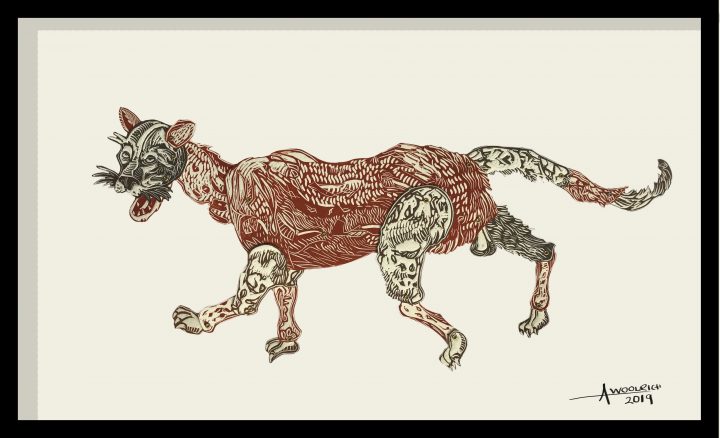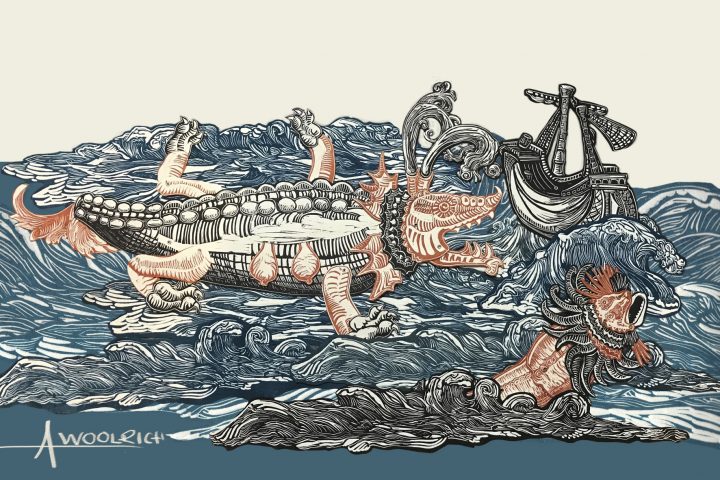Montréal Serai editor Claudia Itzkowich visited Amanda Woolrich in her studio to prepare this piece.
An etching press presides over Amanda Woolrich’s apartment/art studio in Mexico City. Next to it hangs Amanda’s camera, looking down from a rustic iron structure as she plays around with her paper and mica marionettes: one leg 3 mm up, one tail 2 mm to the left, click. Again. And again.
Tortuga en Grabado Animado from Amanda Woolrich on Vimeo.
In order for her “articulated”1 linocut figures to move on the screen, she needs to shoot between 12 and 14 positions per second, a technique that has been in use since at least 1932, with Berthold Bartosch’s animated film, L’idée. And that is the backdrop to the animations she has become known for (or some of them, at least), as the range of techniques she relies on includes watercolour, 2D digital drawing, and many others.c
Her “school” of animation art verges on the anarchic. Her mentor, Tania de León, along with some of the animation artists she admires—Raimund Krumme, Regina Pessoa, Montréal-based Theodore Ushev—and other professors like Alejandro Pérez Cruz, Daniel Manzano and Roberto Carrillo all have one belief in common: animation techniques need to keep evolving, creativity is the norm, and anything goes. This creed explains the diversity of Woolrich’s work: for the music score of one of her films, she provided the composer with a long strip of paper dotted with numbers and colours (ink and watercolour over Japanese paper—an art piece by itself), indicating the intensity she needed for the different moments. For Aquí y allá / Here and there (forthcoming), another black-and-white film starring a stately skeleton, she choreographed and filmed a relative of hers who is a professional actress (Paloma Woolrich), gracing her animated character with an exceptional fluidity of movement.
“The technique of animated engravings has allowed me to understand old prints’ historical journey and adapt it to new media; to reinterpret the work of artists of the past and infuse it with new life by incorporating it in a perspective that helps me understand the world.”
Amanda Woolrich
Amanda Woolrich’s 2019 exhibit in Oaxaca, Miradas al ser: tiempo, espacio y naturaleza en la estampa mexicana [Glimpses into being: time, space and nature in Mexican prints], curated by Berta Gilabert, Luz Rangel Alanís and Luisa Durán, is inspired by the “scientific” drawings of living creatures in the Americas, as drawn in Europe based on depictions sent by explorers and naturalists in a dazzling world they called “new.”
The unintentionally fantastic features of those creatures depicted by men as ambitious as the Comte de Buffon, whose Histoire Naturelle spans 36 volumes, are precious, centuries-old proof of the mysterious cracks and gaps between the empirically serious gaze of the viewers, the ink renderings of their evidence, and the unforeseeable changes their findings underwent when transplanted to unknown worlds through trans-Atlantic travel.

Feline
Based on the work of Georges Louis Leclerc, Comte de Buffon, 18th century
Animated linocut, 21x38cm
With the third decade of the 21st century upon us, those fantastic features are also a moving and amusing lesson in humility for contemporary scientists, as well as an inspiration for Amanda’s art. Her work seems to celebrate the utter creativity of the human gaze, even when the intention is sincerely scientific.
___________________________
1 “Articulated” refers here to the use of hinged segments that allow for movement.

